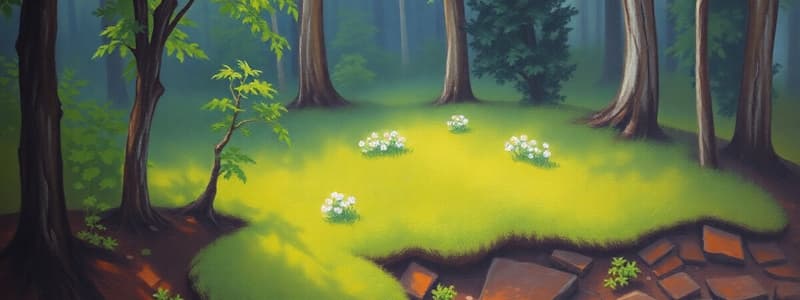Podcast
Questions and Answers
What is one of the primary roles of soil in an ecosystem?
What is one of the primary roles of soil in an ecosystem?
- To offer space and medium for plant growth (correct)
- To absorb sunlight for photosynthesis
- To act as a barrier to prevent erosion
- To provide nutrients exclusively for animals
Which of the following gases is commonly associated with soil composition?
Which of the following gases is commonly associated with soil composition?
- Ozone
- Chlorine
- Sulfur dioxide
- Nitrogen (correct)
How does soil contribute to water purification?
How does soil contribute to water purification?
- By filtering out contaminants as water soaks through it (correct)
- By preventing water from penetrating the ground
- By eliminating all microorganisms present in water
- By absorbing nutrients and releasing them into the water
What effect does the destruction of soil have on ecosystem recovery?
What effect does the destruction of soil have on ecosystem recovery?
What determines how easily gases and liquids flow through soil?
What determines how easily gases and liquids flow through soil?
What is the first step that typically occurs in the formation of soil?
What is the first step that typically occurs in the formation of soil?
What role do lichens and moss play in soil formation?
What role do lichens and moss play in soil formation?
Which type of soil is characterized by the largest particle size?
Which type of soil is characterized by the largest particle size?
What is the primary disadvantage of sandy soil for plant growth?
What is the primary disadvantage of sandy soil for plant growth?
How does the size of sediment particles in silt compare to that in sand?
How does the size of sediment particles in silt compare to that in sand?
What condition is typically unfavorable for plant roots in clay soil?
What condition is typically unfavorable for plant roots in clay soil?
Which type of soil is a combination of sand, silt, and clay?
Which type of soil is a combination of sand, silt, and clay?
What is the ideal condition that forms when sediments, organic matter, and gases accumulate?
What is the ideal condition that forms when sediments, organic matter, and gases accumulate?
What must occur after sediment weathering before soil can effectively form?
What must occur after sediment weathering before soil can effectively form?
Which of the following describes the particle size of clay soil?
Which of the following describes the particle size of clay soil?
Flashcards
Soil Composition
Soil Composition
Soil is a mixture of sediment, minerals, organic matter, air, gases, liquids, organisms, and microorganisms.
Soil Functions
Soil Functions
Soil provides a growing medium for plants, stores water, holds organisms, and is part of biogeochemical cycles.
Soil Development
Soil Development
Soil develops from organic matter, sediments, water, and gases through various processes.
Soil and Ecosystem
Soil and Ecosystem
Signup and view all the flashcards
Soil Types
Soil Types
Signup and view all the flashcards
Soil Formation Steps
Soil Formation Steps
Signup and view all the flashcards
Soil Formation: Weathering
Soil Formation: Weathering
Signup and view all the flashcards
Soil Formation: Erosion/Transport
Soil Formation: Erosion/Transport
Signup and view all the flashcards
Soil Formation: Organic Matter Introduction
Soil Formation: Organic Matter Introduction
Signup and view all the flashcards
Soil Types: Sand
Soil Types: Sand
Signup and view all the flashcards
Soil Types: Silt
Soil Types: Silt
Signup and view all the flashcards
Soil Types: Clay
Soil Types: Clay
Signup and view all the flashcards
Soil Types: Loam
Soil Types: Loam
Signup and view all the flashcards
Soil Profile
Soil Profile
Signup and view all the flashcards
Pioneer Species
Pioneer Species
Signup and view all the flashcards
Study Notes
Soil Composition and Function
- Soil is a complex mixture of sediments, minerals, organic matter, air, liquids, organisms, and microorganisms.
- It's the foundation of ecosystems, supporting plant life and other organisms.
- Soil fulfills four key functions: providing space for plant growth, storing and filtering water, housing organisms, and participating in biogeochemical cycles (e.g., carbon, nitrogen, phosphorus).
- Soil gas content can vary due to organic matter levels and microbial activity (e.g., respiration, decomposition).
- Soil's particle arrangement affects water and gas flow.
Soil Formation and Development
- Soil develops from weathering, erosion, transport, and accumulation of sediments, organic matter, and water.
- Processes can include rock weathering, sediment transport, and organic matter introduction.
- Pioneer species (like lichens and moss) facilitate initial soil formation on barren surfaces.
- Decomposition of organic matter increases soil nutrients and gases.
- Gradual accumulation of organic matter and sediment forms a suitable medium for plant growth.
- Natural disasters like fires or volcanic eruptions can alter soil formation timeframes.
Soil Types
- Four main types: sand, silt, clay, and loam.
- Sand: Largest particle size, allows for rapid water drainage but low nutrient retention.
- Silt: Medium particle size, retains more water and nutrients than sand.
- Clay: Smallest particle size, holds significant amounts of water but has poor drainage.
- Loam: Mixture of sand, silt, and clay, offering a balance of drainage, water retention, and aeration.
Soil Structure
- Soil structure is also categorized as Granular (crumble-like), platy (layered), and columnar (vertical arrangement).
- Different structures allow for varied water and gas flow.
Soil Uses
- Soil is crucial for agriculture (food, fiber production).
- It is also utilized for construction materials, such as in various building materials.
- Understanding soil characteristics is vital for maintaining ecosystem health and constructing strong structures.
Studying That Suits You
Use AI to generate personalized quizzes and flashcards to suit your learning preferences.




